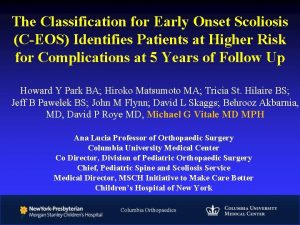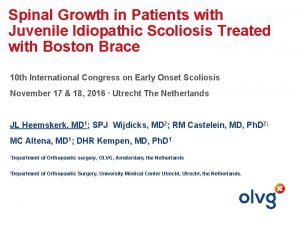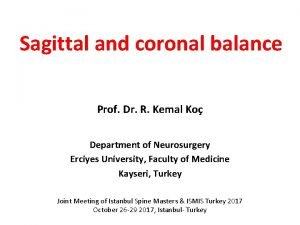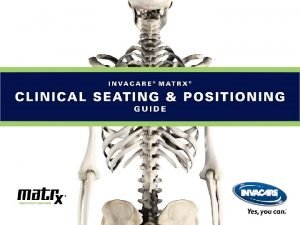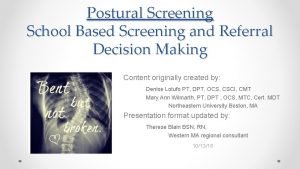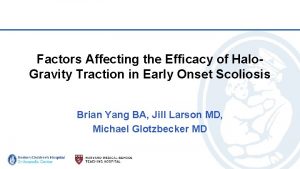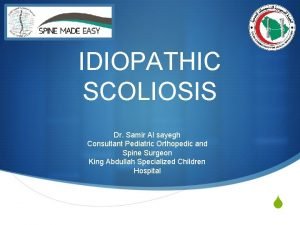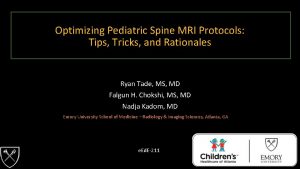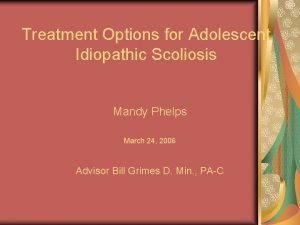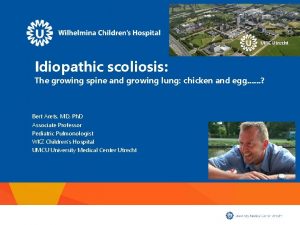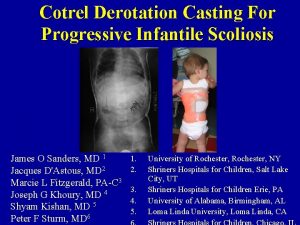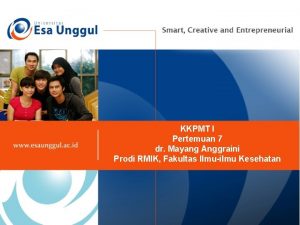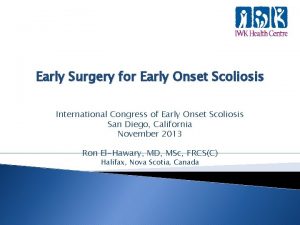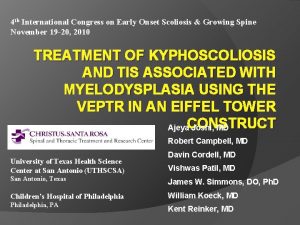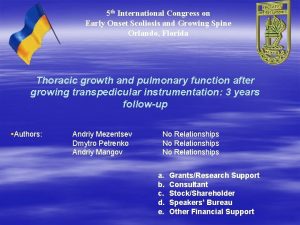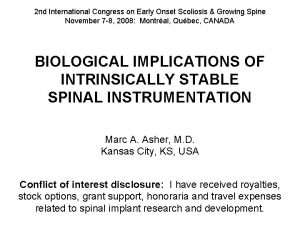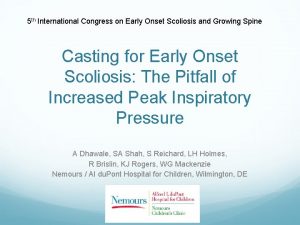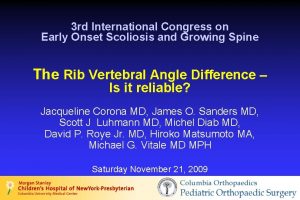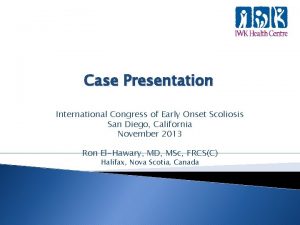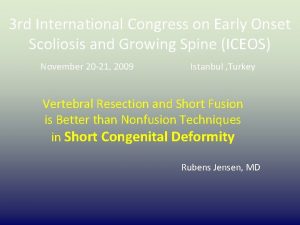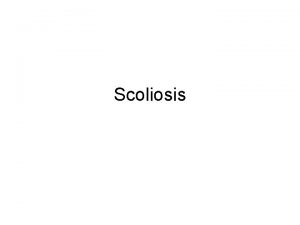7 th International Congress on Early Onset Scoliosis












- Slides: 12

7 th International Congress on Early Onset Scoliosis and Growing Spine San-Diego, California Comparison of Thoracic Growth and Pulmonary Function in Treated versus Untreated Early Onset Scoliosis Patients §Authors: Andriy Mezentsev Dmytro Petrenko No Relationships a. b. c. d. e. Grants/Research Support Consultant Stock/Shareholder Speakers’ Bureau Other Financial Support

Background § Hypothesis: anterior convex epiphysiodesis and growing transpedicular spinal instrumentation improves thoracic symmetry and PFT’s in EOS patients § Design: retrospective study with control group

Materials § 24 EOS patients § 1 group: 12 pts, mean age 14, 1 years, index surgery at mean age 9, 1 years Etiology: IIS – 9, congenital scoliosis - 3 § females – 11, males - 1 § Mean follow-up 4, 6 years § Surgeries: - anterior convex epiphysiodesis, growing transpedicular instrumentation - 11 pts - ante-posterior hemivertebra resection, growing transpedicular instrumentation – 1 pt - In 8 patients final fusion has been performed - 2 group: 12 nonoperated pts, mean age 15 years, scoliosis onset before the age of 5 Etiology: IIS – 6, JIS – 7, congenital scoliosis - 1 § Females – 12.

Methods - Cobb angle - Left and right hemithorax length (LHL/RHL) - transverse thorax length (TTL) - left and right hemithorax vertical length (LHVL/RHVL) - left and right AP hemithorax length (LAPHL/RAPHL) - PFT: FVC & FEV 1 - t-test TTL LHL/RHL RAPHL LHVL/RHV L

1 st group: Infantile idiopathic scoliosis, 8 yo 2007 2013

1 st group: Infantile idiopathic scoliosis, 8 yo 46° 98° 46° 37° 33° 10° 2007 13° 2007 2013 13° 2013

1 st group: Infantile idiopathic scoliosis, 8 yo 50° 53° 20° 32° 40° 35° 19° 2007 2012 2013

1 st group: Infantile idiopathic scoliosis, 8 yo Preop 5 yrs postop

2 nd group: Infantile idiopathic scoliosis, 12 yo 126º 90º

Results 1 st group preop Cobb 74, 3± 3, 28 1 st group end of f/u 31, 6± 2, 92 2 nd group t-test Left hemithorax length 7, 7± 1, 55 10, 8± 1, 01 121, 3± 12, 87 5, 06 13, 8± 1, 29 3, 26 Right hemithorax length 12, 4± 1, 29 7, 3± 1, 01 5, 0± 0, 51 3, 12 Transverse thoracic length 14. 3± 1, 33 19, 1± 1, 73 16, 8± 1, 61 2, 01 Left hemithorax vertical length 8, 2± 1, 01 13, 4± 1, 21 12, 2± 1, 19 1, 9 Right hemithorax vertical length 10, 1± 1, 78 12, 9± 1, 41 9, 1± 0, 85 3, 7 Left AP hemithorax length 8, 1± 0, 92 10, 2± 1, 12 6, 0± 0, 4 4, 65 Right AP hemithorax length 7, 6± 1, 11 9, 6± 1, 05 4, 1± 0, 32 7, 24

Results 1 st group preop 1 st group end 2 nd group of F/U t-test FVC 1520± 128, 3 72, 5% (52, 3 -86, 7%) 3624, 1± 385, 4 89, 3% (65 -129%) 2981, 1± 329, 9 73, 01% (68, 7 -94%) 2, 76 FEV 1 1470± 136, 7 57, 7% (50, 1 -61, 3%) 3140, 8± 327, 7 93, 46% (47 -114%) 2759, 7± 303, 11 1, 6 84, 57% (62 -92, 8%)

Conclusion -anterior convex epiphysiodesis and posterior growing transpedicular instrumentation improve thoracic symmetry and preserve spinal growth - actual FVC and FEV 1 values and actual/predicted ratio increase during follow-up after index surgery - PFTs are better in operated versus nonoperated patients
